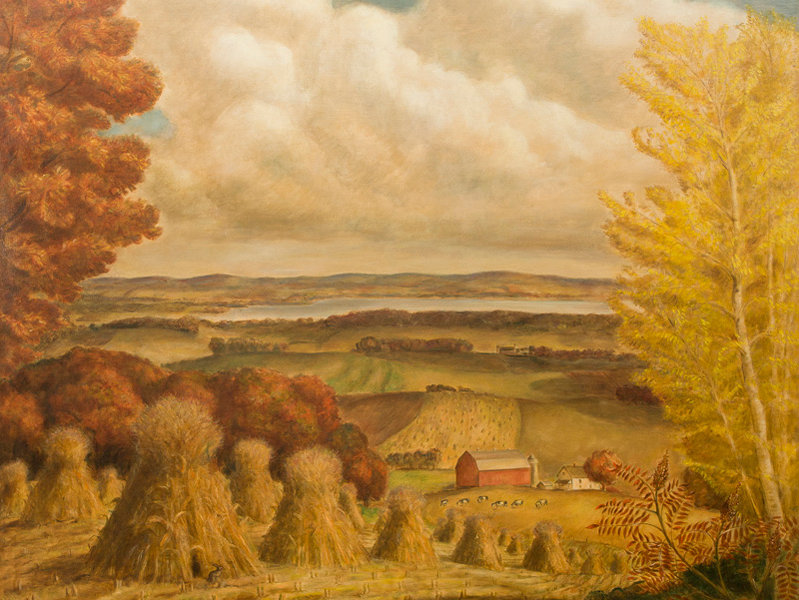John Steuart Curry’s relationship with his native state of Kansas was as troubled as a convulsing tornado, and the raging soul of John Brown. Curry became famous when he gave that state indelible public images.
Paintings of their swirling escalators to Oz and the anarchistic slave-liberating Brown, and fundamentalist baptismal dousings in a wood barrel, embarrassed early Kansas critics likely hoping his fame might help boost the state’s nation image in the newly modern and chic 1920s.
But Curry painted "the American scene," with the same real-life observational sensibility held by Thomas Hart Benton and Grant Wood, the three major Midwestern "Regionalist" artists.
Meanwhile, Wisconsin and in its visionary Big Ten university lay poised, deep in its rolling hills and forests, to woo the man who helped define a new art largely independent of modern European influences.
Wisconsin made all the right moves, as is evident in the artwork and underlying story of "John Steuart Curry at Home in Wisconsin," the new exhibit at the Museum of Wisconsin Art in West Bend, running through Sept. 14.
This show's name is slyly docile and domestic. And MOWA made a good move itself, when it re-defined part of its mission to exhibit not only native Wisconsinite artists like photographer Edward L. Curtis, but also artists, like Curry, who "lived in the state for a period of time and had a transformative experience here," as MOWA executive director Laurie Winter explains.
An impressive show at the in Madison at the Elvehjem Museum of Art (now, The Chazen Museum) in 1998 traced Curry’s impact in defining the Midwest from the standpoint of the era’s natural and societal turmoil. The MOWA exhibit provides Wisconsinites with a fuller sense of a crucial if more pastoral story – of rural outreach-style education and collective state-side war efforts.
But he would also sometimes fill this cumuli-graced air with flying UW footballs and always with an implicit but big buzzing vibration called "The Wisconsin Idea," which helped this American scene painter transform into a state citizen and ambassador to his adopted state in the progressive sense the idea espoused.
In November 1936, Curry was the first artist featured in the new LIFE magazine which would help "America’s foremost painter of cyclones and circuses" move squarely in the middle of American consciousness.
Kris L. Christiansen, Dean of the College of Agriculture, lured Curry to Wisconsin in a letter on display here, and hired him for $4,000 a year as the nation’s first "artist in residence" at a university.
By then, fame had virtually compelled Curry to move to the East Coast, but he was never comfortable in the high modernist climate there, and he longed to return to the Midwest. Kansas sent no zephyr whispers his way and, by 1939, the state became immortalized as the ultimate tornado state, when Dorothy murmured "Toto, I’ve a feeling we’re not in Kansas anymore."
Nor was Curry who, though less technically skilled as a draftsman than the other big Regionalists, had a windswept big sky vision that understood the power and meaning of the sprawling American landscape.
As the often-acerbic Benton himself wrote of Curry’s famous "Wisconsin Landscape" (not in this show): "It is at first sight slightly repellent." Benton’s second thought was "this damn thing is a masterpiece of some sort."
Benton surely sensed how Curry’s Kansas eye fell hard for Wisconsin’s shapelier curves, and the art reflected the way the UW-driven Wisconsin Idea was modernizing the farmscape, striving to bring modern know-how in synchronicity with that extraordinary natural resource.
The shy but affable Curry embraced his state ambassador role here. He understood the symbolic resonance of his work, making connections "from Capitol domes to silo domes," as MOWA curator Graeme Reid puts it.
There’s clearly something vast and even heroic about the verdant potency of the three great landscapes seen here big shoulder to big shoulder – "Wisconsin Farm Scene," "View of Madison" and "Landscape with Grouse" – all painted in 1941 as a triptych. Together for the first time in decades, Reid says, they radiate the sweep and grandeur of "God’s country" – the fields, hills and clouds seem to float amongst the three canvases like a big-as-the-sky entity.
Curry’s technical mastery of the fertile landscape increases with each ensuing section, as if he’s bringing it all slowly into focus for us. The underbellies of the clouds glow golden, reflecting the sun-drenched wheat and haystacks below. You can see how the UW Ag department had taught area farmers to till across the grain of a hill to minimize runoff erosion, a sometimes catastrophic effect that contributed to the 1930s Dust Bowl.
More good state P.R. comes in "Our Good Earth." A photograph of Curry painting it reveals his male model as a gawky hayseed whom Curry transformed into a square-jawed, musclebound super farmer bristling with rural manifest destiny, which in 1941, also signified a defiance of the fascist Axis of Europe.
Indeed, Curry allegorizes the war story in the mural "Youth Helps Rebuild a World." A group of rural Americans march towards the smoky haze of a desolate, bombed-out city in Europe, in the mural’s far right portion. Yet this work from 1946 implicitly acknowledges that this city could be the Allied-bombed Dresden, or even Hiroshima – profoundly tempering whatever jingoism one might initially detect.
The young woman in the mural curiously wears a skirt far shorter than 1940s fashion. UW-Madison art historian James Dennis sees a pattern in Curry’s depiction of women. His paintings "transgressed any fixed art historical label in their woman imagery," Dennis has written. So a young woman like this "left traditional academic forms of allegorization behind, the first requirement of modern independence."
Dennis adds that Curry created "a contemporary ‘girl-woman’ to whom he assigned his most crucial social causes."
The more time passes, the taller Curry’s serenely brawny landscapes and progressive murals seem to stand, in the wind, in the stately clouds and in the long light of history.







